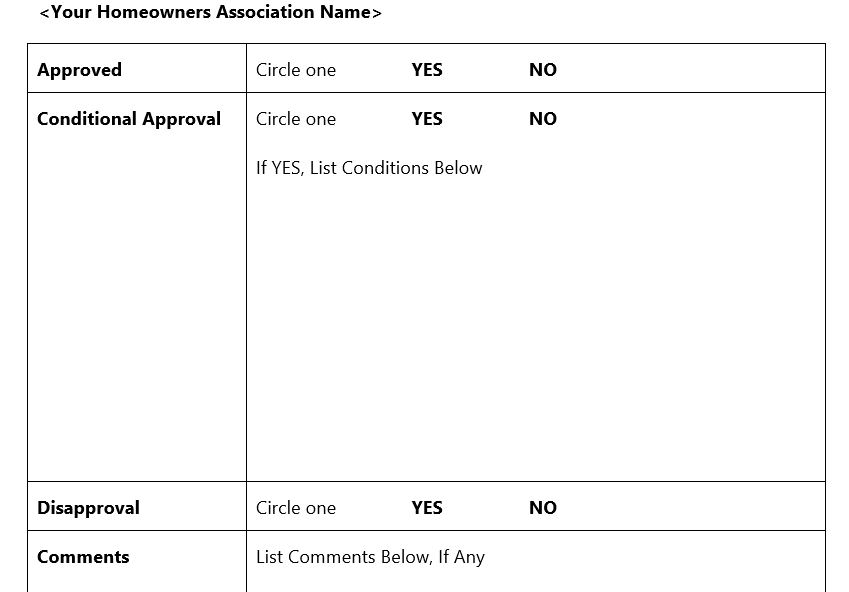HOA architectural approval procedures are a crucial part of maintaining the visual identity of your community. The need to fill up HOA architectural approval forms can be a source of frustration for homeowners; so is the wait for the approved HOA architectural review form, which can take weeks. Here’s our take on how you can make your HOA architectural approval process as efficient, transparent, and quick as possible. We’re also throwing in an HOA architectural approval form you can start with, too.
HOA Architectural Approval Process: Why Your Community Needs One
First, let’s take a look at what your community derives from a proper HOA architectural approval process. Why do you need an HOA architectural board in the first place?
The HOA architectural process and the architectural review board that works on it are your primary ways to maintain the architectural standards of your community. One of the best features that a managed community can have is architectural harmony. It’s up to a proper HOA architectural approval process to ensure that this visual cohesion is maintained, even through years of renovations, additions, and repairs by homeowners.
For communities fortunate enough to have access to ocean views or mountain vistas, the HOA architectural approval process also ensures that access to these features is protected. Nobody would appreciate it if that gorgeous lakeshore view is suddenly blocked off due to a home addition from a neighbor. It’s up to the HOA architectural board to make sure that all exterior modifications or physical improvements adhere to community standards.
The HOA architectural approval process is needed with large structural modifications. But as you can see later in the HOA architectural approval form template, the process also deals with minor improvements, as well.
 Things like the installation of dormer windows or a new awning will also usually require approval from the HOA architectural board, even if these additions don’t have a major impact on the look of the community. Even these small details have to be evaluated on whether they aesthetically fit with the rest of the neighborhood, or whether they have the potential to be distracting eyesores instead.
Things like the installation of dormer windows or a new awning will also usually require approval from the HOA architectural board, even if these additions don’t have a major impact on the look of the community. Even these small details have to be evaluated on whether they aesthetically fit with the rest of the neighborhood, or whether they have the potential to be distracting eyesores instead.
Filling up and submitting HOA architectural approval forms can be seen as an additional hurdle by the homeowners, and it can be a source of friction between the HOA and residents. It’s important for the board members to take time to explain to them how the HOA architectural approval process will not only benefit the community, it will also benefit their homes as well, even if they are not the ones doing renovation at the time.
Neighborhoods that are aesthetically harmonious and well-maintained are seen as exclusive and more desirable to live in. As a result, the property values of the surrounding homes will greatly benefit. This visual cohesion cannot be maintained without a solid HOA architectural approval process in place. A detail-oriented HOA architectural board that oversees this process is also invaluable in maintaining a high community architectural standard for years to come.
A Proper HOA Architectural Approval Process
 A solid and efficient HOA architectural approval process need not be a roadblock for residents who just want to improve their property. Before anything else, a proper HOA architectural approval process should be one that’s fully consistent with the community’s Covenants, Conditions & Restrictions (CC&Rs) and other governing documents.
A solid and efficient HOA architectural approval process need not be a roadblock for residents who just want to improve their property. Before anything else, a proper HOA architectural approval process should be one that’s fully consistent with the community’s Covenants, Conditions & Restrictions (CC&Rs) and other governing documents.
Not all communities require approval from an HOA architectural board for modifications to homeowner properties or common areas. Whether you are just starting out with a preliminary plan for your HOA architectural approval process, or if you’re looking to improve your current procedures, it never hurts to do a review of your HOA governing rules first.
The HOA architectural board, who is responsible for the process, is usually a committee that is separate from the board. A separate HOA architectural committee means that it can be composed of architectural and property management experts who have the experience and skills to administer the community’s architectural standards.
Since the approval process can result in an application being rejected, it must be a fair and speedy process for everyone. A fair, prompt and transparent HOA architectural approval process should have these characteristics:
- The process should be included in detail in the HOA CC&Rs and governing rules.
- The process should mandate prompt deadlines for submissions, decisions, and the other steps in between.
- The process should require a response issued within a reasonable time for applications and requests.
- All decisions must be made in good faith and in compliance with current regulations.
- All decisions must be made in writing.
HOA Architectural Approval Process and the ARC
 The architectural review committee, or “ARC” in short, is responsible for collecting the information needed to evaluate all proposed installations that are forwarded to them. There are several documents that the ARC may require from the HOA member, depending on the type of modifications involved.
The architectural review committee, or “ARC” in short, is responsible for collecting the information needed to evaluate all proposed installations that are forwarded to them. There are several documents that the ARC may require from the HOA member, depending on the type of modifications involved.
The first document that a homeowner needs to submit is the ARC request form. You can find an online version of our ARC request form here. The ARC request form, at its minimum, should be able to collect a detailed description of the proposed improvement or modification, as well as its location on the property. It should also collect information on the paint color or finish, as well as the materials that will be used.
Of course, the ARC request form should also capture information about the homeowner, including their home address and contact information. A typical ARC form will also require information about the contractors involved with the project, as well. The ARC request form will also require the homeowner to provide a reasonably accurate estimate of the time it would take to complete the project.
Aside from descriptive information, the ARC request should also be able to capture photos and drawing plans as well. This may include photo samples of the structure, architectural plan drawings, landscaping details, and other related attachments.
A Proper HOA Architectural Approval Process Keeps A Community Beautiful
Keeping a community beautiful and aesthetically pleasing is not a one-man job – you need the whole community doing their part. Need a hand with your HOA architectural approval process? Our passion is to serve communities like yours, let us know how we can help!
RELATED ARTICLES:
- What Is An Architectural Review Committee? And What Does It Do For An HOA Community?
- Green HOA Practices To Apply For An Eco-Friendly Community
- 9 HOA Springtime Landscaping Rules For The Community







